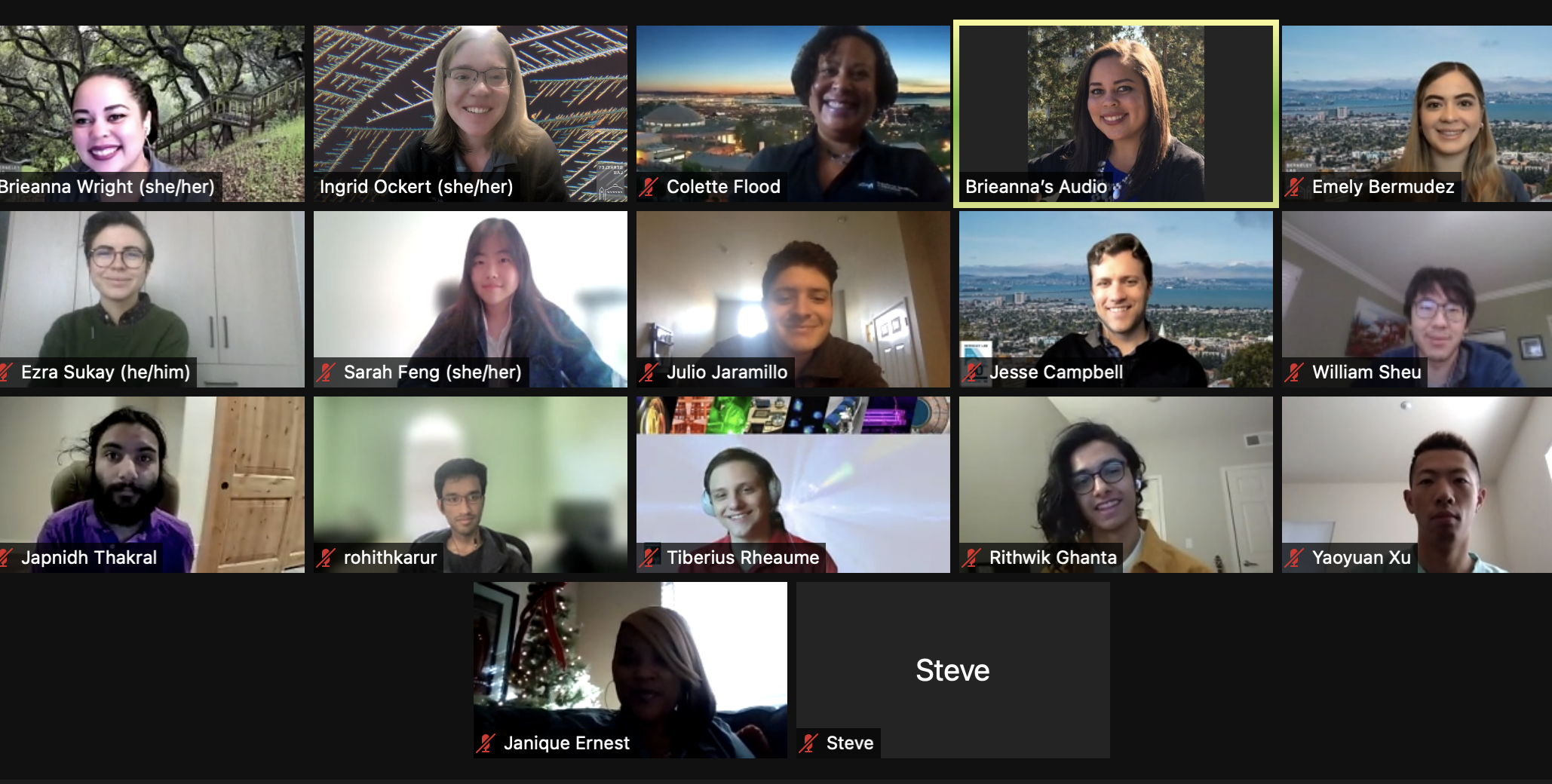
Interns and WD&E staff gathered virtually for the Fall 2021 Intern Poster Session.
How does basic laboratory research shape our knowledge about the world around us? This term, 10 interns from Workforce Development & Education’s programs asked themselves that very question. Over 15 weeks, WD&E’s cohort of Fall 2021 interns collaborated with Lawrence Berkeley National Laboratory’s researchers and scientists on investigations into the natural world. They helped their teams discover more about watershed systems, the age of stars, and recyclable plastics.
On December 1, 2021, these interns presented their findings to their colleagues and friends. WD&E Director Colette Flood started the morning by thanking the interns for their hard work. “Thank you for being tenacious,” she told them. Addressing the mentors, she said “We appreciate your dedication to the program and the interns. I am confident that we will continue to be very successful in bringing science solutions to the world.”
What science solutions did this cohort of interns investigate?
What if we could completely recycle plastic?: Rithwik Ghanta, a BLUR intern, spent the term working closely with an interdisciplinary team helmed by Brett Helms that has been investigating infinitely recyclable plastics. “My goal was to create a computational model which could direct the experimentalists to know which [plastic] is recyclable and which one is not,” Ghanta explained. Over time, the model that Ghanta helped his team develop will become more useful as more molecules are added to the data set and more robust methods of machine learning are developed. Ghanta loved being able to work on a project that was so “readily impactful.”
What if we could modulate the creation of greenhouse gasses? Sarah Feng, a CCI intern, investigated how microbes in very cold climates release carbon dioxide and other greenhouse gases into the atmosphere. Feng learned that permafrost contains 1.6 billion tons of carbon, “which is around twice as much as is in the Earth’s atmosphere.” “As global and soil temperatures warm,” she told her audience, “Microbes eat at this carbon and release it as greenhouse gases.” Feng and her research team hope that their research will help scientists understand how a rise in global temperatures will affect [arctic] communities. Ideally, more understanding will help scientists plan ways to modulate the release of greenhouse gases.
What if we could predict droughts? Jesse Campbell, a CCI intern, was part of the SAIL (Surface Atmosphere Integration Field Laboratory) team. Along with his mentor, he mapped the connections between the atmosphere and the subsurface for controlling water flow at the source of water for the Colorado River. He hopes his work will help his team predict droughts in the future. Campbell noted that working virtually didn’t prevent him from having to fulfill an internship experience. “[Working remote] has been fun and it’s been very efficient in many ways.” he remarked, “Even though we’re working remotely, I feel like I’m really connected to [the project] because I spent a lot of time on Google Earth tracking where all these instruments are located…I feel like I’ve been involved on-site.”
Over their term, the interns all felt like they had grown as researchers. For his work, Ezra Sukay, a SULI intern, learned how to simulate and model a gravitational lens for the first time. At first, Ezra explained, “I was really intimidated by the [modeling software], so it felt like a really big accomplishment.” Japnidh Thakral, a SULI intern who helped design computer chips for the Large Haldron Collider, felt like his work had brought him closer to his research community.
Many of the interns described how their work helped them understand more about how basic research could help solve big, pressing scientific problems. For instance, Feng noted, “I never really thought about permafrost because it feels so far away, it’s invisible, we don’t see it. But there’s so much happening down there…it could have such profound implications on global warming and greenhouse gas emissions. It was really interesting learning about this.” “This has impacted where I want to go,” Ghanta commented, “I think I would want to work somewhere applied with tangible outcomes that I can know about.” By working on these interdisciplinary projects, interns gained experience that has helped focus their future trajectories.
CCI and SULI are Department of Energy-funded national programs and are hosted by all the national laboratories. BLUR is managed by Workforce Development and Education.
–Ingrid Ockert, Marketing Communications Coordinator

